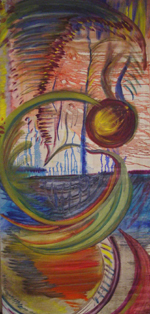FEILE-FESTA
Spring 2006
Poetry
Eritrea My Ithaca
- L. Calio
Escape
- P. Corso
Losing a Country
- M. C. Delea
Inclined
- EF Di Giorgio
A Sicilian in Potter’s Field
- G. Fagiani
a color called family
- J. Farina
The Past
- M. M. Gillan
Don’t Speak
- D. Gioseffi
Sharkia
- G. Hanoch
The Old Blatherskites
- T.S. Kerrigan
Seal Woman’s Lament
- C. Loetscher
Barefoot
- C. Lovin
L'amara Primavera
- Q. Marrone
Understudy
- L. A. Moseman
Brooklyn and America
- F. Polizzi
Death of Brahan Seer
- T. Reevy
For Sean Sexton
- T. Sexton
The City at the Center of the World
- A. Verga
Right Angles
- R. Viscusi
Agrigento
- J. Wells
FEILE-FESTA
Spring 2006
Prose
No Matter How Far
- L. Dolan
Ireland and Sicily: Two Islands
- E. Farinella
Southern Exposure
- M. Lisella
Because She Was
- J. O’Loughlin
Flying
- P. Schoenwaldt
Review of DANCES WITH LUIGI
- T. Zeppetella
FEATURED ARTIST
Melissa Kennedy
BIOGRAPHIES
Contributors
|
BOOK REVIEW Paolicelli, Paul. Dances with Luigi : a grandson's determined quest to comprehend Italy and the Italians. New York : St. Martin's Press, 2000. We carry in every cell of our bodies the genes of our entire ancestral lineage. One of those genes must engender in us the desire to find out from where the rest of them came. This has made genealogy one of the most common hobbies and internet applications. We seek the details of our ancestors' lives. How did they live? What motivated them? What were their paths of immigration around the globe? Much of this is unknowable but we can speculate about ancient tribes or great historical figures that we may count among our ancestors. Ridiculous? Well consider that Genghis Khan has an estimated 16 million descendents living today, and DNA analysis of populations is progressing. Paul Paolicelli had the desire, the funds and the flexibility to spend several years in Italy researching his ancestors' lives and the social conditions in which they lived. Along the way he learns a little of the Italian language, culture and history, travels to his ancestral hometowns and discovers distant cousins who welcome him. Since this is Italy , there are the ancillary benefits of magnificent scenery, antiquities, art and architecture, food and vino , music and la festa , etc. All of this is reason enough to recommend Paolicelli's story of this sojourn, Dances with Luigi . But if you have the genealogy bug or a love of Italy , it is a must. Paolicelli discovers that a sense of history surrounds everything in Italy . His paternal grandfather, whose birth records proved exceedingly difficult to find, came from Basilicata , a very poor region in Southern Italy . This area has been inhabited for over 40,000 years, so the Romans, and even their predecessors, the Lucanians, were relatively recent. His maternal grandfather emigrated from Gamberale, a town in the mountainous Abruzzo region directly east of Rome . Early settlers were the Samnites, whom Cicero described as the toughest of Rome 's opponents. Speculation has it that some ancient Romans retreated there after the barbarian invasions. One of the family lines is actually a form of the name Julius, as in Caesar. The town is actually named for a leader of later arrivals, the Longobardi, who came from what is now Scandinavia after the fall of Rome . Thousands of years of history have shaped these people. A professor tells him that the Paolicelli name is ancient and derived from “little Pauls,” early followers of the Apostle Paul. (Or, less intriguingly, could there have been an ancestor Paolo who was short?) The book's title is a little unfortunate since it doesn't inform the reader of the main theme. Luigi is an Italian living in Rome who becomes a friend and traveling companion to the author. While helping Paolicelli with the subtler meanings of the Italian language and psyche, he helps present to the reader the contrasts between modern Italy and America , and the social conditions in both countries during the early twentieth century. This makes the book more than the story of one family. It is also a story of the Great Migration from Il Mezzogiorno of millions of people who played an essential role in twentieth century American industry and culture. People who left the towns where their families had lived for hundreds of years, to find work in a foreign land with a strange language and customs. They overcame antagonism and discrimination and predators like the Black Hand. Paolicelli makes the case implicitly here and explicitly in a subsequent book, Under the Southern Sun , that their success was a consequence of the values learned in southern Italy over one hundred years ago. The only institutions that could be relied upon were the family and the Church. The strength of the family attachment was illustrated by a tragic accident that befell Paolicelli's grandfather, Francesco. While working with a crane that ran on tracks, the railroad car ran over and severed his legs. What did this Italian immigrant say as he bled to death? “ Povri figli mie, povri figli mie ” – my poor children. Not all Italian immigrants were as selfless and hard-working as Francesco, but many of them did succeed and left a great heritage to their families. There is a lot here to recommend this book to readers with interests in the people, history and culture of Italy , as well as family researchers of any nationality. |
